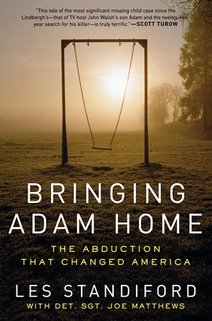
04 Mar 2011 03:21:55
What do you know about kidnapping? You think that this happens with special sort of people? Don't be naive, because the victim of kidnapping may become everyone.
This story is about the most insolent and unprecedented kidnapping in American history because — largely through the efforts of Adam's parents, John and Reve Walsh — it revolutionized the way in which local, state and federal authorities investigate cases involving missing and murdered children. Because it is such a famous case, you might think you already know the story; the authors quickly demonstrate that you would be mistaken.
Les Standiford, the author of 15 non-fiction books and novels including "The Man Who Invented Christmas" (2008), tells the story with help from Joe Matthews, the detective who finally solved the case while working for John Walsh's TV show, "America's Most Wanted."
The book has been likened to Truman Capote's classic "In Cold Blood," but the comparison is not apt.
Unlike Capote, Standiford does not bend facts for the sake of art, and his writing is not self-consciously literary. He spills out the narrative in a precise, matter-of-fact style — a wise choice for a story laced with so much heartbreak, gore and perversion. A more apt comparison: "Bringing Adam Home" is one of the finest true-crime books since Thomas Thompson's "Blood and Money" (1976).
The authors meticulously recount Adam's kidnapping from a Sears store in Hollywood, Fla.; the fruitless search for the missing boy; and the subsequent discovery of his severed head bobbing in a canal a few miles away. And they briefly sketch the tireless work by the boy's bereaved parents on behalf of other missing and murdered children.
But the heart of the book is an investigation of the investigators — an expose of unforgivable bungling by the Hollywood, Fla., police department, followed by decades of behavior that is hard to explain away as anything other than a conspiracy to cover up its incompetence.
Standiford and Matthews painstakingly build their case against the police, detailing a dozen leads that were not followed up, obvious questions that were not asked, witnesses who were ignored, reports that were incomplete (and in some cases falsified), evidence that was not examined and vital physical evidence that was lost. Most damning of all, Hollywood police discounted repeated confessions by a serial killer who knew details of the crime that had never been made public. The authors name names and pull no punches.
This story is about the most insolent and unprecedented kidnapping in American history because — largely through the efforts of Adam's parents, John and Reve Walsh — it revolutionized the way in which local, state and federal authorities investigate cases involving missing and murdered children. Because it is such a famous case, you might think you already know the story; the authors quickly demonstrate that you would be mistaken.
Les Standiford, the author of 15 non-fiction books and novels including "The Man Who Invented Christmas" (2008), tells the story with help from Joe Matthews, the detective who finally solved the case while working for John Walsh's TV show, "America's Most Wanted."
The book has been likened to Truman Capote's classic "In Cold Blood," but the comparison is not apt.
Unlike Capote, Standiford does not bend facts for the sake of art, and his writing is not self-consciously literary. He spills out the narrative in a precise, matter-of-fact style — a wise choice for a story laced with so much heartbreak, gore and perversion. A more apt comparison: "Bringing Adam Home" is one of the finest true-crime books since Thomas Thompson's "Blood and Money" (1976).
The authors meticulously recount Adam's kidnapping from a Sears store in Hollywood, Fla.; the fruitless search for the missing boy; and the subsequent discovery of his severed head bobbing in a canal a few miles away. And they briefly sketch the tireless work by the boy's bereaved parents on behalf of other missing and murdered children.
But the heart of the book is an investigation of the investigators — an expose of unforgivable bungling by the Hollywood, Fla., police department, followed by decades of behavior that is hard to explain away as anything other than a conspiracy to cover up its incompetence.
Standiford and Matthews painstakingly build their case against the police, detailing a dozen leads that were not followed up, obvious questions that were not asked, witnesses who were ignored, reports that were incomplete (and in some cases falsified), evidence that was not examined and vital physical evidence that was lost. Most damning of all, Hollywood police discounted repeated confessions by a serial killer who knew details of the crime that had never been made public. The authors name names and pull no punches.

